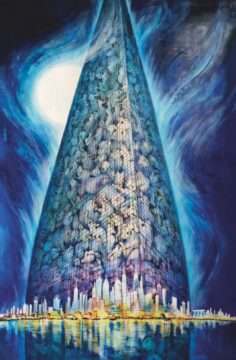Karan Mahajan in Bookforum:
 THE LINGUIST ROSS PERLIN is an encyclopedist of New York City’s microworlds. In 2016, when he took me and ten others on a tour of Ridgewood, Queens, he alerted us to the presence of a dozen languages spoken in a two-square-mile radius, including Syriac, Yiddish, Malayalam, Haitian Creole, and Kichwa. He led us into an ancient, black-and-white-tiled, espresso-scented Sicilian social club, where a retired nonagenarian factory worker proudly discussed his dialect, Partanna. Later, we drank beer and ate bratwurst at the Gottscheer Hall, a tavern and cultural center for the Gottscheers, a tiny community of Germanic people who fled their native Slovenia following the World Wars. Their language, Gottscheerish, is a thirteenth-century dialect of German that now survives largely in New York.
THE LINGUIST ROSS PERLIN is an encyclopedist of New York City’s microworlds. In 2016, when he took me and ten others on a tour of Ridgewood, Queens, he alerted us to the presence of a dozen languages spoken in a two-square-mile radius, including Syriac, Yiddish, Malayalam, Haitian Creole, and Kichwa. He led us into an ancient, black-and-white-tiled, espresso-scented Sicilian social club, where a retired nonagenarian factory worker proudly discussed his dialect, Partanna. Later, we drank beer and ate bratwurst at the Gottscheer Hall, a tavern and cultural center for the Gottscheers, a tiny community of Germanic people who fled their native Slovenia following the World Wars. Their language, Gottscheerish, is a thirteenth-century dialect of German that now survives largely in New York.
Such diversity is easy to take for granted in New York, ambient wallpaper for a city powered by finance, but as Perlin writes in his comprehensive and brilliant new book Language City: The Fight to Preserve Endangered Mother Tongues in New York (Atlantic Monthly Press, $28), the situation is more complex than meets the eye—or ear. Half of the world’s seven thousand languages “are likely to disappear over the next few centuries,” which makes New York, with its teeming biome of seven hundred languages, “a last improbable refuge for embattled and endangered languages.” But New York—and the United States—exerts its own relentless pressure on immigrants to assimilate into dominant mother tongues like English and Spanish, and we may have already reached “peak linguistic diversity.” Perlin’s heroic task in the book is to provide a linguistic snapshot of this moment of language explosion and implosion.
More here.
Enjoying the content on 3QD? Help keep us going by donating now.
